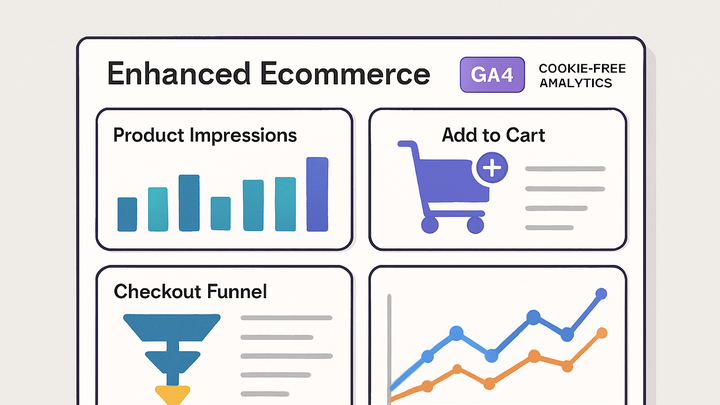Published on 2025-06-22T03:10:02Z
What is Enhanced Ecommerce? Examples in GA4 and PlainSignal
Enhanced Ecommerce is an advanced analytics feature that extends beyond basic transaction tracking to capture detailed user interactions throughout the shopping journey on an ecommerce site. It includes events such as product impressions, clicks, add-to-cart actions, coupon usage, checkout steps, and refunds. By recording these interactions, businesses gain granular insights into how customers discover products, where they drop off in the funnel, and which promotions drive conversions. Enhanced Ecommerce is supported by major analytics platforms like Google Analytics 4 (GA4) and PlainSignal, a cookie-free analytics solution. Implementing Enhanced Ecommerce helps optimize product placement, improve checkout processes, and ultimately increase revenue by understanding customer behavior at each stage.
Enhanced ecommerce
Advanced ecommerce tracking capturing product views, add-to-cart, checkout steps, and promotions for deeper insights.
Overview of Enhanced Ecommerce
Enhanced Ecommerce provides a comprehensive way to measure user interactions with products throughout the customer journey. Unlike basic ecommerce tracking that only records purchases, Enhanced Ecommerce tracks impressions, detail views, promotions, and checkout behavior. This depth of data empowers businesses to make informed decisions about product placement, promotional strategies, and checkout optimization.
-
Definition
A method of capturing detailed ecommerce interactions such as product impressions, clicks, add-to-cart, and transactions to understand user behavior from discovery to purchase.
-
Evolution
Enhanced Ecommerce evolved to address limitations of standard ecommerce tracking by adding stages like promotions, coupon codes, and detailed checkout funnels.
Key Metrics and Features
Enhanced Ecommerce introduces metrics that go beyond purchases, allowing analysis of each step in the user journey. These include product impressions, cart additions, coupon usage, checkout stages, and refunds. Understanding these metrics reveals where users engage or drop off, helping businesses refine their marketing and UX strategies.
-
Product impressions
Counts how often each product is viewed on listing pages or search results, indicating visibility and user interest.
-
Add-to-cart and remove-from-cart
Tracks when users add or remove items from their cart, showing purchase intent and potential friction points.
-
Checkout behavior
Monitors user progression through defined checkout steps to pinpoint drop-off points and optimize the funnel.
Implementing Enhanced Ecommerce in GA4
Google Analytics 4 (GA4) supports Enhanced Ecommerce through predefined events like view_item, add_to_cart, and purchase. You can implement it via gtag.js or Google Tag Manager by pushing ecommerce data into the dataLayer and mapping it to GA4 events.
-
Gtag.js example
Use gtag.js to send ecommerce events. Here’s a sample purchase event:
-
Code example
<script async src='https://www.googletagmanager.com/gtag/js?id=GA_MEASUREMENT_ID'></script> <script> window.dataLayer = window.dataLayer || []; function gtag(){dataLayer.push(arguments);} gtag('js', new Date()); gtag('config', 'GA_MEASUREMENT_ID'); gtag('event', 'purchase', { transaction_id: 'T12345', value: 35.43, currency: 'USD', items: [{ item_id: 'SKU_123', item_name: 'Widget', price: 15.00, quantity: 2 }] }); </script>
-
-
Gtm implementation
With Google Tag Manager, define a Custom Event trigger for ecommerce actions and map dataLayer variables to GA4 event parameters.
Implementing Enhanced Ecommerce in PlainSignal
PlainSignal provides a cookie-free analytics solution that supports Enhanced Ecommerce tracking with minimal setup. By embedding the PlainSignal script and using its data API, you can capture ecommerce events without relying on cookies.
-
Tracking code snippet
Insert this PlainSignal snippet into your site header to start tracking ecommerce events:
-
PlainSignal snippet
<link rel='preconnect' href='//eu.plainsignal.com/' crossorigin /> <script defer data-do='yourwebsitedomain.com' data-id='0GQV1xmtzQQ' data-api='//eu.plainsignal.com' src='//cdn.plainsignal.com/plainsignal-min.js'></script>
-
-
Event tracking
Use PlainSignal’s JavaScript API to send Enhanced Ecommerce events like view_item, add_to_cart, and purchase in JSON format.
Best Practices
Adhere to these guidelines to ensure reliable Enhanced Ecommerce tracking and actionable insights.
-
Consistent data layer
Maintain a uniform data layer schema across pages to simplify event mapping and reduce implementation errors.
-
Clear naming conventions
Use descriptive event and parameter names so reports are self-explanatory and easy to analyze.
-
Regular validation
Use real-time reports and debug tools to verify that ecommerce events are firing correctly and data is accurate.
Use Cases
Enhanced Ecommerce empowers businesses to optimize product catalogs, marketing efforts, and checkout experiences by leveraging detailed interaction data.
-
Product listing optimization
Analyze impression and click data to feature high-performing items and improve underperforming ones.
-
Checkout funnel analysis
Identify stages with high abandonment and test UX or incentive changes to reduce drop-off.
